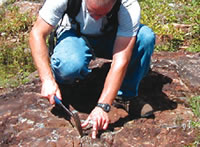 Prospectors, junior mining companies and communities across Northern Ontario are hoping that pending changes to the province’s Mining Act won’t dampen the fortunes of Ontario’s lucrative mineral exploration industry.
Prospectors, junior mining companies and communities across Northern Ontario are hoping that pending changes to the province’s Mining Act won’t dampen the fortunes of Ontario’s lucrative mineral exploration industry.
Scheduled to be unveiled in the first few weeks of December, the amendments flow from Ontario Premier Dalton McGuinty’s promise in July "to modernize the way mining companies stake and explore their claims to be more respectful of private land owners and Aboriginal communities." The initiative is also a direct result of recent Supreme Court rulings establishing a duty to consult and accommodate First Nations with respect to development on their traditional lands.
The Ontario government published a discussion paper in August and held a series of public and stakeholder meetings to solicit comments and suggestions on how to consult First Nation communities without jeopardizing the health of the exploration industry.
"Our task is to find a balance," said Minister of Northern Development and Mines (MNDM) Michael Gravelle in the introduction to the discussion paper. "By getting it right, we can ensure that all communities have the opportunity to reap the benefits of the current mining boom."
One of the key differences of opinion related to the demand by some First Nation groups that prospectors and exploration companies notify First Nation communities of their intentions prior to staking claims.
Garry Clark, executive director of the Ontario Prospectors Association (OPA), is confident that won’t happen.
"We agree there needs to be consultation with First Nation communities, but we don’t believe it’s possible to consult before staking," he said. "The competitive nature of our industry and the success of our industry is dependent on our ability to go out and stake ground without having to warn someone that we’re coming."
Instead, the OPA suggests a notification system that would follow the staking of claims.
"Certainty is one of the key principles of a sustained and competitive exploration environment," states an OPA position paper. "Erosion of certainly on any front can affect the attraction of high risk exploration dollars….Changing the political regime or policies of the exploration landscape can push the investor from the jurisdiction to a perceived safer jurisdiction."
The stakes are considerable. Exploration spending in Ontario totalled $500 million in 2007 and was scheduled to reach $625 million this year before the current financial turmoil began impacting credit markets. Ontario’s mining industry as a whole contributes in excess of $10 billion to the provincial economy.
As the OPA points out in its position paper, "the present system, though poorly directed by legislation or regulation, has numerous success stories where industry and (First Nation) communities are both benefiting."
Several First Nation communities have welcomed the business and employment opportunities made available as a result of exploration activities on their traditional lands, but a standoff between Plantinex Inc. and leaders of the Kitchenuhmaykoosib Inninuwug (KI) community last summer over exploration drilling near Big Trout Lake, 600 kilometres north of Thunder Bay, led to arrests and jail sentences for KI chief Donny Morris and five other community members.
In its discussion paper, the government cautioned that it "may consider introducing an enhanced regulatory approach" requiring prospectors and exploration companies to provide advanced notification of early exploration work.
"I don’t think that’s a problem, as long as it’s not too onerous," said Clark. "We got rid of work permits in 1996 as part of the Conservative government’s red tape cuts. At the time, they were set up to let the Ministry of Natural Resources know where you were working and what you were doing, but copies went to the Ministry of Labour, the Ministry of the Environment and MNDM. We don’t want a system that goes to all of the ministries, but we think if it goes to MNDM, they can inform the First Nation communities where the work is going to occur."
A requirement to consult and accommodate First Nation communities after claims have been staked could work, states the OPA position paper "if there were timelines for response from First Nation and Métis communities."
Noting that "funding for exploration is time-sensitive and could be lost in a long drawn out process," the OPA also insists on an arbitration process.
"We believe the devil will be in the details, which will be in the regulations," said Clark. "What’s going to be introduced in December is the enabling legislation. It won’t have any meat on it. The regulations are where the meat is and that’s going to take another 10 months."
The government’s consultation process also sought input from the public on the province’s decision in July to set aside 225,000 square kilometers in "an interconnected network of conservation lands" encompassing more than half of the province’s Far North. The areas selected would be reserved for tourism and traditional Aboriginal uses.
The land use planning process is expected to take between 10 and 15 years to complete. Claim staking and exploration will continue to be permitted during this timeframe, but the opening of new mines in the Far North will require community land use plans supported by local Aboriginal communities.
The OPA discussion paper urges the government to spend money on the collection of more geoscience data from the region to prevent the parking of high mineral potential areas.


.jpg;w=120;h=80;mode=crop)